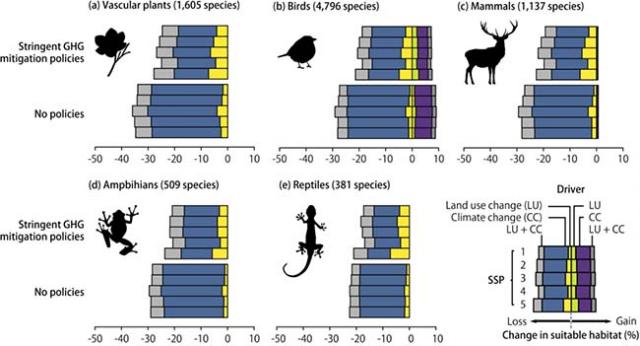Home > Research > Research Results > Research Results 2020 > The Compatibility of Biodiversity Conservation and Greenhouse Gas Mitigation Activities
Update:April 8, 2020
Main content starts here.
The Compatibility of Biodiversity Conservation and Greenhouse Gas Mitigation Activities ―Loss of Biodiversity Can be Controlled by Climate Stabilization Efforts—
| Article title |
Biodiversity can benefit from climate stabilization despite adverse side effects of land-based mitigation |
|---|---|
| Author (affiliation) |
Haruka Ohashi (a), Tomoko Hasegawa (b), Akiko Hirata (c), Shinichiro Fujimori (d), Kiyoshi Takahashi (c), Ikutaro Tsuyama (a), Katsuhiro Nakao (a), Yuji Kominami (a), Nobuyuki Tanaka (e), Yasuaki Hijioka (c), Tetsuya Matsui (a) (a) Center for International Partnerships and Research on Climate Change, FFPRI, Tsukuba, Ibaraki, Japan. (b) Ritsumeikan University, Kyoto, Japan. (c) National institute for Environmental Studies, Tsukuba, Ibaraki, Japan. (d) Kyoto University, Kyoto, Japan. (e) Tokyo University of Agriculture, Tokyo, Japan. |
| Publication Journal |
Nature Communications, 10, 1-11, 20 November 2019 DOI:10.1038/s41467-019-13241-y( External link ) |
| Content introduction |
Biodiversity has provided various benefits that are essential for human survival. However, biodiversity on Earth has rapidly declined owing to human activities, such as land conversion, in the past 100 years. Moreover, climate change is also considered a threat to biodiversity. Reducing the impact of climate change by reducing energy consumption related to fossil fuel and introducing renewable energy is crucial to prevent this biodiversity loss. However, previous studies have not considered the negative effects of large-scale land conversion via stringent greenhouse gas (GHG) mitigation activities, such as the encouragement and expansion of afforestation activities and the cultivation of bioenergy crops, which are necessary to prevent global warming. The possibility of GHG mitigation activities negatively impacting biodiversity has been discussed, but there has been no research that scientifically supports this theory. Therefore, in this study, we evaluated the degree of biodiversity loss in each case, both with and without the implementation of GHG mitigation activities using multiple statistical-estimation methods for the first time on a global scale. To evaluate biodiversity around the globe, we selected occurrence records for 8,428 species belonging to five taxonomic groups (vascular plants, birds, mammals, amphibians, and reptiles). Based on these data, we built an ecological niche model (* 1) for predicting areas suitable for habitation (potential suitable habitats) on a global scale. By applying future climate and land-use scenarios to the completed model, the prediction of potential suitable habitats of living organisms corresponding to these conditions and their visualization on a map was possible. For future climatic conditions, two cases were assumed: “when GHG mitigation activities are being promoted to achieve a 2°C target (with countermeasures)” and “when global warming progresses without countermeasures (no countermeasures).” Furthermore, the degree of biodiversity loss was compared and evaluated by assuming five different socioeconomic scenarios (* 2) and integrating models predicting future land-use change and ecological niche models that match each socioeconomic condition. Simulation results showed that the loss of global biodiversity can be reduced by promoting GHG mitigation activities and achieving the 2°C target, even while considering the negative impact of large-scale land conversion. A comparison of the simulation results of the five types of socioeconomic scenarios revealed that the scenarios actively promoting initiatives for building a sustainable society (sustainable scenarios) showed the lowest biodiversity loss. This was considered as the case because measures, including strong land-use regulations, adopted in the sustainable scenario contributed to the conservation of natural environments that maintain high biodiversity. This result indicates that the compatibility between biodiversity conservation and achieving the 2°C target depends on the speed and direction of future social and economic development. The method developed in this research facilitated the analysis of the relationship between GHG mitigation activities and biodiversity on a global scale. This method can be used not only for GHG mitigation activities but also to assess the impact of various policies for a sustainable society on biodiversity. In the future, it will be possible to explore a roadmap to achieve multiple sustainable development goals using the method developed in this study. * 1 Ecological niche model.A statistical method for estimating the probability of the existence of the habitat of a species from the current habitat and environmental factors such as temperature, precipitation, and land use. * 2 Socioeconomic Scenario A scenario that describes the potential for the occurrence of various socioeconomic developments that are not directly related to global warming. Five scenarios, i.e., “sustainable,” “middle-of-the-road,” “regional rivalry,” “increasing inequality,” and “fossil fuel dependence,” assuming different socioeconomic conditions (population, GDP, degree of progress in energy technology, etc.), were used in this study.
Figure 1. Outline of the study: In this study, we compared the degree of future biodiversity loss in each case, both “with” and “without” GHG mitigation activities. Accordingly, we predicted that there would be less loss of biodiversity “with” GHG mitigation activities, in which the temperature rise is preserved within 2°C (top), than “without” GHG mitigation activities (below), in which the habitat of many species would be lost owing to a significant rise in the temperature.
Figure 2. Predicted impacts on biodiversity: Rate of change (%) of potential suitable habitats for each taxon in the 2070s predicted under each of the five socioeconomic scenarios for both “with” and “without” GHG mitigation activities. The contributions of drivers are shown in different colors (land change, climate change, and the synergy effects of the two factors). Potential suitable habitats are reduced for many organisms other than birds, but the extent of decline is expected to be less dramatic “with” GHG mitigation activities rather than “without” GHG mitigation activities. |
Copyright © Forest Research and Management Organization. All rights reserved.


